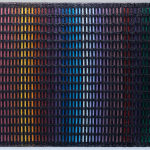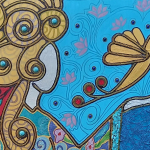
Trieste, la magica città che le ha dato i natali, ha contribuito a formare il suo carattere effervescente e curioso, vitale tanto quanto lo è la gamma cromatica che utilizza nelle sue opere; la bellezza e la cultura appartengono da sempre alla città al confine est dell’Italia, a un passo dalla elegante e imperiale Vienna che le ha permesso di fruire delle influenze artistiche che si sono susseguite nel corso dei secoli trasformando la capitale del Friuli Venezia Giulia in un luogo dove la tradizione e la semplicità dell’incontro tra terra, cielo e mare, ammirabile dalla baia che la ospita, convive con l’eleganza e la raffinatezza di un popolo culturalmente curioso e sempre al passo con i tempi. Pertanto Erna Fossati, il cui carattere rispecchia ed esalta quello dei suoi concittadini, è stata da sempre affascinata dall’arte, amandola come spettatrice senza però mai immaginare di poter un giorno esserne lei stessa protagonista; invece, come spesso accade, le sue energie creative erano rimaste latenti perché in qualche modo devono maturare e trovare un naturale percorso, canale comunicativo, fino poi a liberarsi rendendole impossibile resistere al richiamo creativo. Al termine di questo percorso inconscio, si è praticamente trovata davanti alla prima tela avvertendo l’impulso di dare vita a una realtà non riscontrabile nella contingenza, perché per lei dipingere significa astrarsi da tutto ciò che è intorno ed entrare in una dimensione di gioia, di colore, di vivacità e di buoni sentimenti. Erna Fossati ama le sfide e la pittura lo è anche perché dipinge istintivamente, da autodidatta, senza aver avuto quella formazione accademica che le avrebbe permesso di effettuare studi sul colore e sullo stile eppure mostra un equilibrio cromatico che da un lato si armonizza alla raffinatezza dei paesaggi e delle donne narrate, dall’altra svela il suo carattere vitale e orientato alla positività, quella che emerge quando si volge lo sguardo verso il sole piuttosto verso l’ombra degli accadimenti più spiacevoli. Il suo stile è Art Decò, quel movimento pittorico sorto agli inizi del Novecento di cui fu icona e massima rappresentante Tamara de Lempicka; Erna Fossati ama raffigurare quell’epoca spensierata e divertente degli Anni Venti, quando le donne cominciavano a essere emancipate, coraggiose, a mostrare la loro forza e indipendenza uscendo dagli schemi, accorciando le gonne, osando fumare in pubblico e scegliendo abiti e accessori vistosi e sfarzosi per sottolineare la gioia della fine del periodo buio del primo conflitto mondiale. E dunque nelle sue opere si respira allegria, fascino, opulenza sottolineata dall’applicazione sulla tela di materiali che contribuiscono a enfatizzare il senso di ricchezza degli abiti delle sue donne: glitter, perle, cristalli, pendenti in strass che riflettono, danno rilievo alle immagini rendendole più vitali e vivaci di quanto non facciano già i colori e le atmosfere che le circondano. In Lady Summer
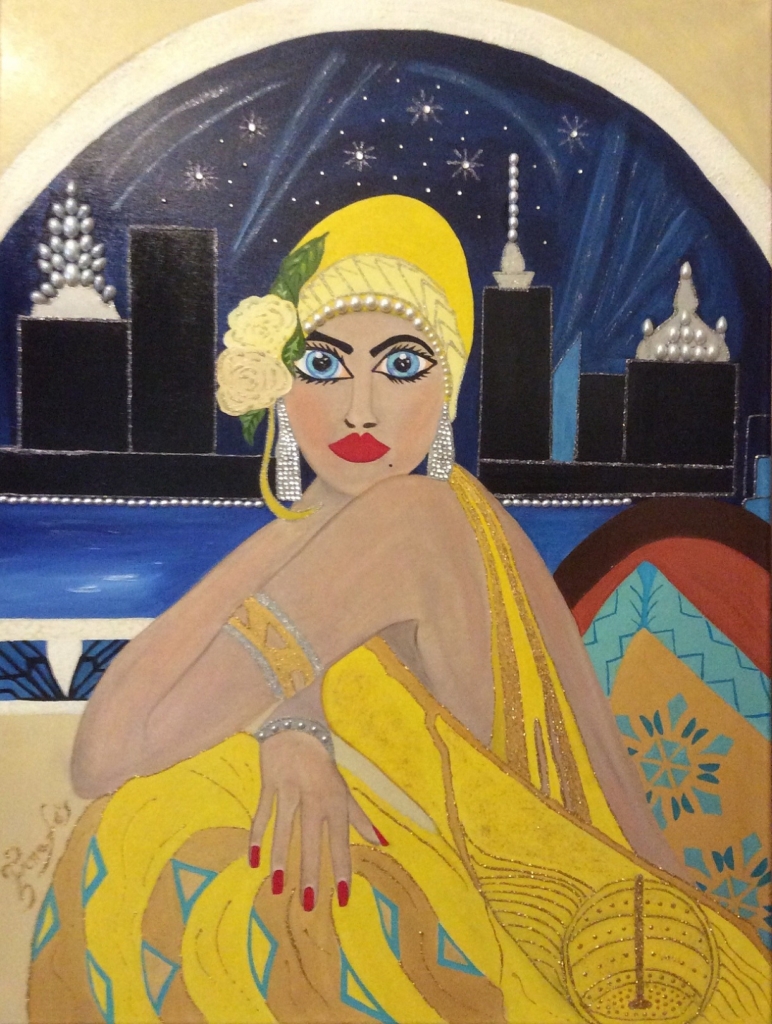
l’artista descrive la magia di una notte d’estate di tanti anni fa, quando il mondo era un posto più piacevole, quando la spensieratezza era la protagonista di feste all’insegna del bel vivere recentemente ritrovato dopo le brutture della guerra e dunque con un sapore ancora più dolce e intenso; la donna protagonista scruta l’osservatore come se in qualche modo volesse suscitarne l’ammirazione non solo per la sua essenza ma anche in virtù dell’apparenza curata nei minimi dettagli che vengono sottolineati dall’inserimento di perle, di glitter e di cristalli che riflettono la luce generando l’effetto ottico delle stelle e delle luci nella città che emergono nella notte. E ancora in Première Dame
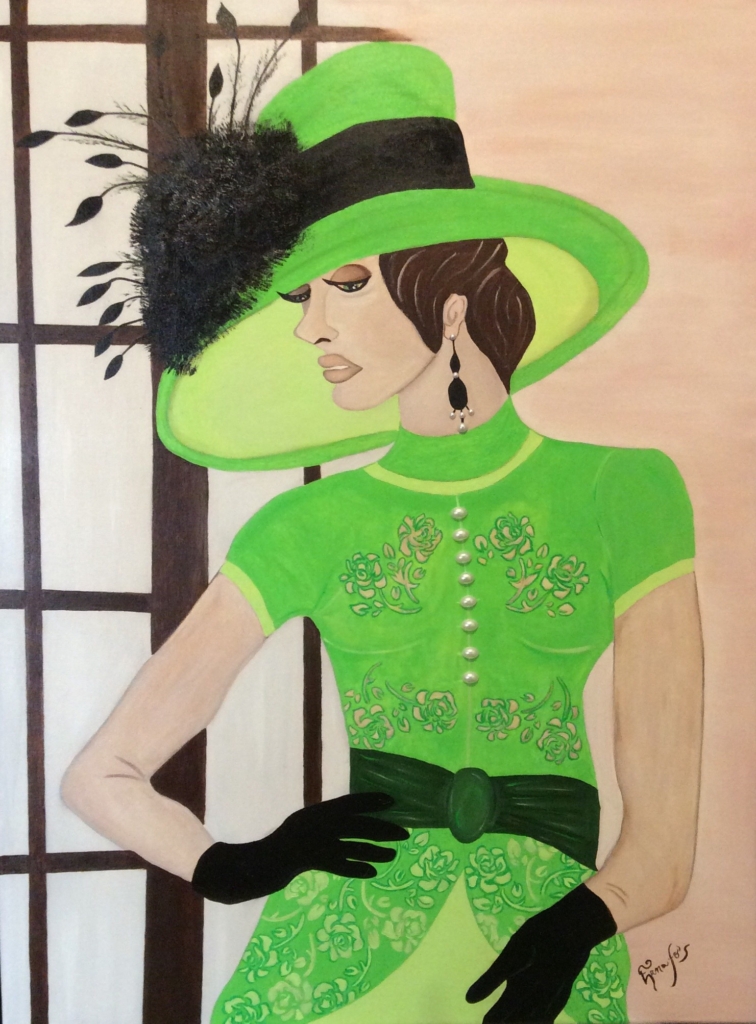
la donna sembra quasi nascondere il proprio volto con il cappello, un po’ per timidezza un po’ per superbia, come se volesse chiarire che non tutti possono essere alla sua altezza; in qualche modo Erna Fossati sembra avere uno sguardo nostalgico nei confronti di un’epoca in cui la donna era rispettata e trattata con estrema riverenza ma al tempo stesso ha un atteggiamento ironicamente giocoso nei confronti di quel modo di porsi persino troppo snob verso uomini non sufficientemente interessanti da poter attrarre la sua attenzione. Attraverso l’intervista di oggi approfondiremo la conoscenza di questa particolare e interessante artista.
Erna, lei ha cominciato a dipingere relativamente tardi, pur essendo sempre stata appassionata di arte; qual è stato il momento in cui ha sentito l’esigenza di esprimere le sue sensazioni sulla tela? Cosa ha provato quando ha terminato il suo primo dipinto?
A dire il vero è cominciato tutto in modo casuale, in una giornata particolarmente noiosa, mi sono decisa ad aprire uno scatolone dove tenevo le mie cose, quelle che avevo raccolto quando sono andata via dal posto di lavoro. Aprendolo mi sono ritrovata in mano un block notes e delle matite colorate, che usavo per intrattenere i bambini dei clienti; così mi sono messa a disegnare e a colorare uno dei miei pappagalli, che a dire la verità non era venuto granché bene pur essendomi spesa con impegno tutto il pomeriggio… però alla fine mi sono resa conto di quanto mi fossi rilassata nel fare questa cosa; la sera lo raccontai al mio compagno il quale il giorno dopo mi regalò una valigetta in legno che fungeva anche da cavalletto, con dentro colori acrilici, pennelli, e una piccola tela pronta per essere dipinta. Quello fu il mio inizio alla pittura e da quel giorno di sette anni fa, non ho più smesso. Ovviamente essendo autodidatta e senza alcuna esperienza pittorica, ho lavorato e faticato molto, ho cominciato con i colori acrilici per un paio di anni, chiedendo a pittori esperti più consigli e tecniche possibili, alcuni mi hanno aiutata, altri se la sono cavata con un “prova, riprova e riprova ancora, finché ci arrivi”, ma soprattutto devo essere grata ad internet, dove ho trovato video di pittori che mostrano diverse tecniche e modalità per fare quello che avevo in mente; e così prova e riprova, oggi a distanza di anni posso dire di essere arrivata a dei buoni risultati, soprattutto lavorando con i colori a olio, anche se credo ci sia sempre qualcosa di nuovo da imparare.
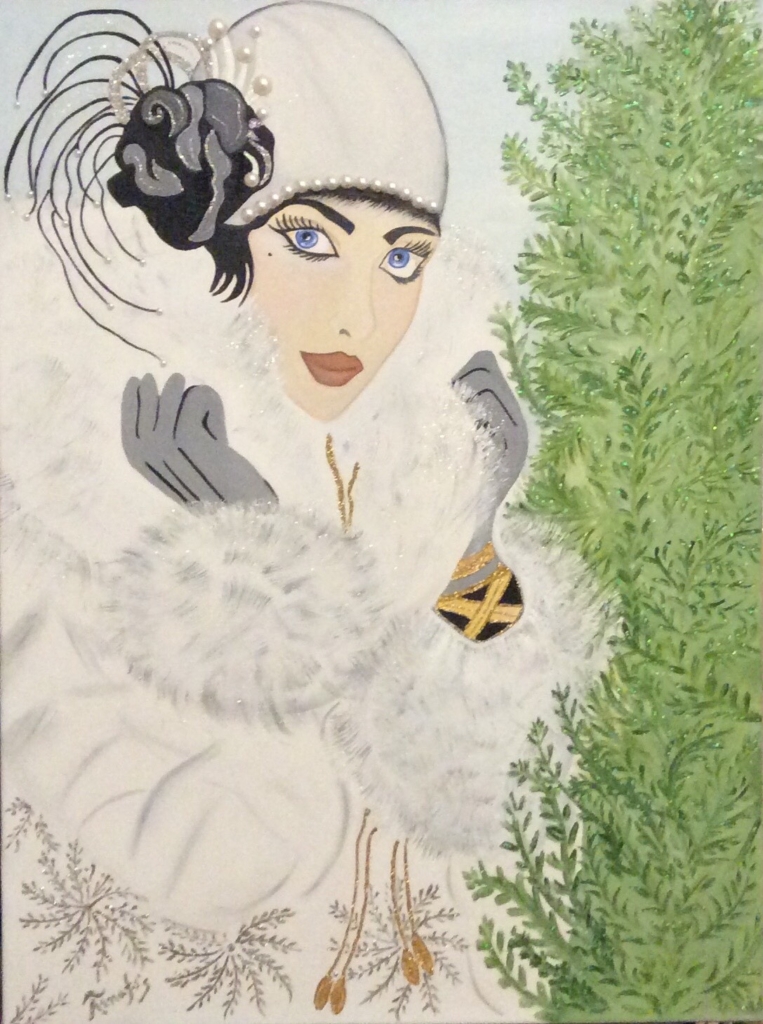
Il suo stile è Art Decò, a cosa è dovuta la scelta di un approccio pittorico tanto affascinante ma insolito? Qual è il messaggio che desidera arrivi attraverso le sue opere?
Art Decò… ci sono arrivata nel tempo. Agli inizi i miei lavori si basavano su dipinti di pappagalli, la mia passione vera, in quanto in passato ne sono stata allevatrice; ho fatto anche una personale e pubblicato un catalogo su questo tema riscuotendo un discreto successo. Poi però ho sentito il bisogno di mettermi alla prova con il figurativo femminile, trovando un mio stile personale. Avevo il desiderio -e perché no, anche un po’ di presunzione- che chi vedesse i miei lavori pensasse “Questo lo ha fatto Erna, è il suo tratto”; e così lavorandoci sopra vedevo che il ritratto classico non mi entusiasmava, mancava sempre quel “qualche cosa che”. Perciò su internet mi misi alla ricerca di artisti che mi trasmettessero non so neanche io cosa, ma poi trovai la biografia e i lavori di Tamara de Lempicka e me ne innamorai. Da quel momento sono sempre alla ricerca di tutto ciò che è moda, usi e costumi degli anni Venti e Trenta, anche perché sono una collezionista seriale di cappelli.
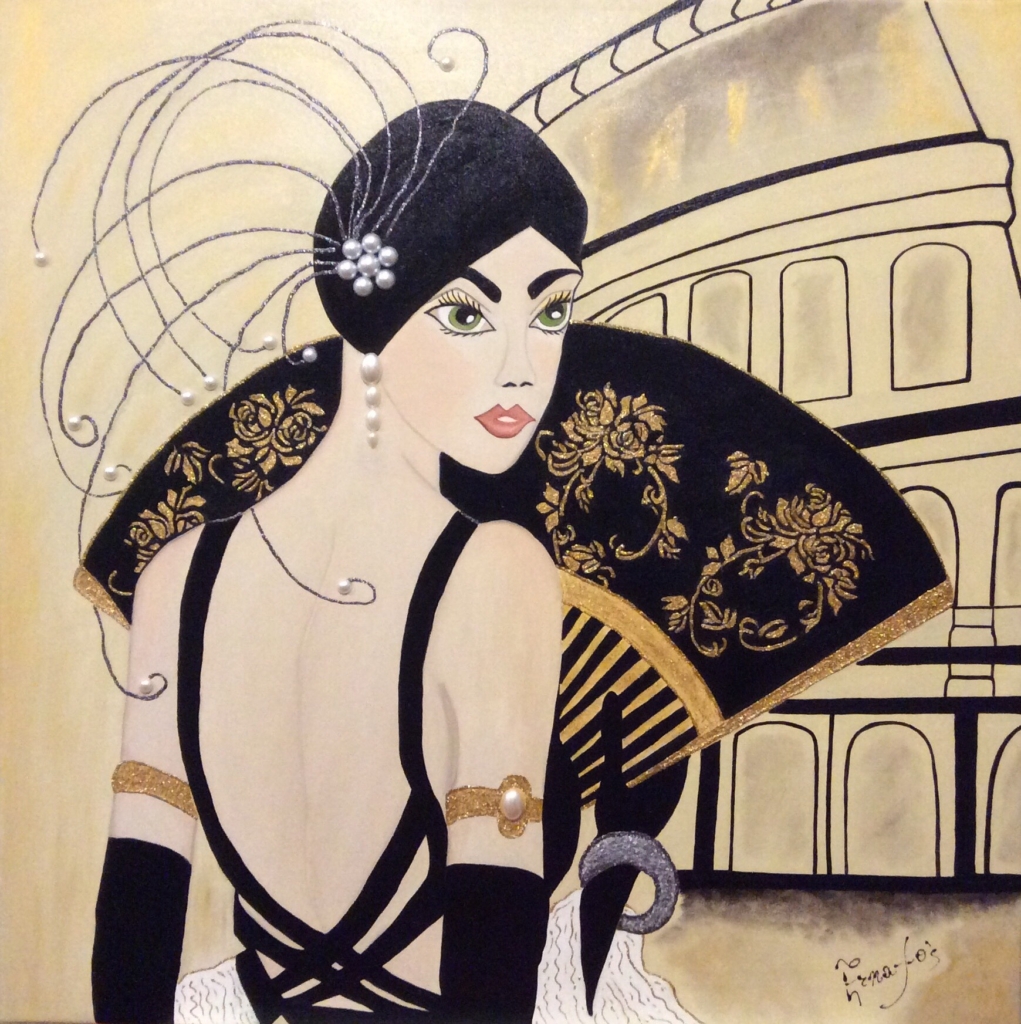
Quanto è importante mantenere il legame con i valori formali, ma anche in fondo interiori, del passato in un presente che sembra aver messo in secondo piano tutto ciò che in qualche modo era sintomo di rispetto e di riguardo nei confronti di se stessi e del prossimo? Crede si possa ritrovare, anche attraverso l’arte, un equilibrio tra esteriorità e sostanza che oggi appare pendere molto di più verso la sola inconsistenza della prima?
Non è semplice tenere fermi i valori del passato in un presente in cui tutto sta degenerando; da bambina ho ricevuto un’educazione severa, dove il buongiorno o il buonasera anche con chi non conoscevi faceva parte della buona educazione, dunque per me che non sono esattamente giovane, sono formalità e valori di rispetto ancora importanti. Oggi una formalità come il saluto verso sconosciuti rappresenta una stranezza che induce gli altri a guardarti con diffidenza, come se si sentissero invasi perché queste accortezze sono diventate inconsuete, anche se per me sono ancora fondamentali. Tuttavia non mi piace stare ferma nel passato, mi piace vivere giorno per giorno con quello che arriva. Dipingo il passato, perché mi piace l’eleganza e la classe delle donne di un tempo; le mie ragazze sono civettuole, eleganti, appariscenti e benestanti, non mi piace la banalità e la sciatteria. L’arte salverà il mondo? Non credo, sono in pochi che apprezzano veramente l’arte, se un artista vivesse solo d’arte morirebbe di fame, molti non comprendono il lavoro, lo studio, i costi dei materiali e le ore, i giorni impiegati per realizzare una tela, preferiscono andare nei centri commerciali a comprare una stampa con pochi spiccioli, ma nonostante tutto chi dipinge lo fa per passione, non può farne a meno.
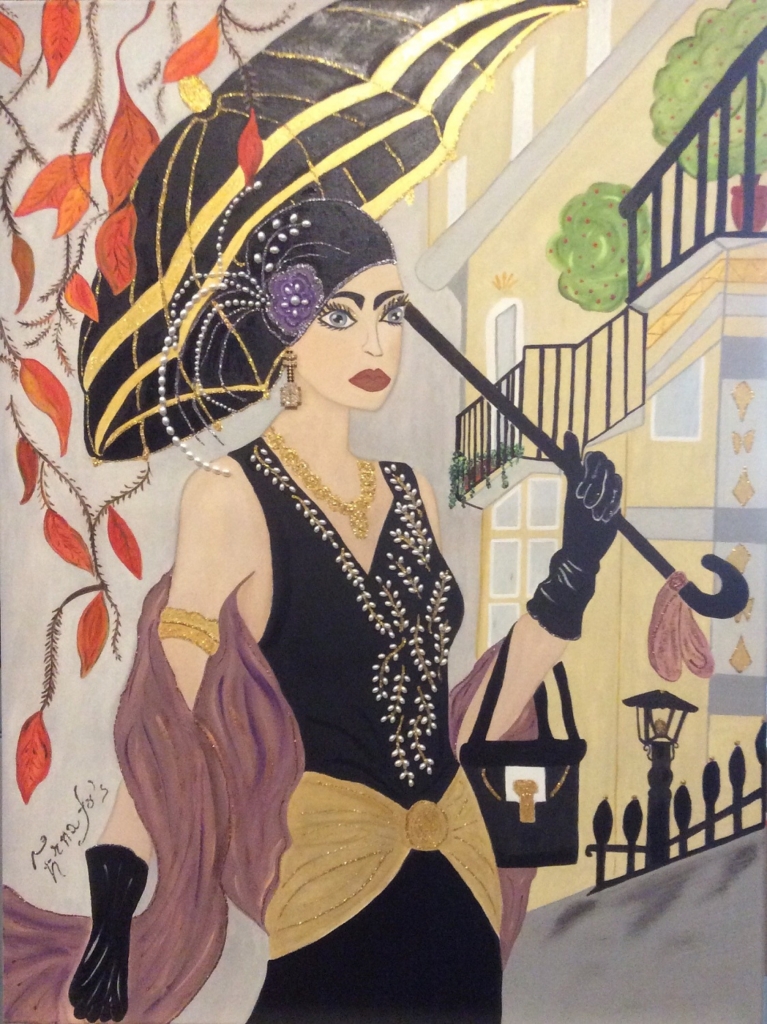
Non si può parlare di Art Decò senza citare Tamara de Lempicka che sicuramente l’avrà ispirata, ma lei è da sempre un’amante dell’arte. Quali sono stati gli altri grandi artisti del passato che le hanno fatto desiderare di diventare a sua volta protagonista di quel mondo?
Come già detto Tamara de Lempicka è stata la mia musa ispiratrice, ma trovo meravigliose le opere di altri artisti del passato e anche contemporanei: mi entusiasmano Giovanni Boldini, Alphonse Mucha, Kostantin Razumov, Leopoldo Metlicovitz, Alexander Gunin, Lorraine Wood, Carol Bak, Carol Cavalaris e molti altri.
Ha al suo attivo molte mostre su tutto il territorio nazionale e anche all’estero, quali sono i suoi prossimi progetti?
I miei prossimi progetti? Per il 2023 qualche collettiva, forse una personale nella mia bella Trieste, e mi piacerebbe partecipare a un paio di collettive all’estero… poi si vedrà!
ERNA FOSSATI-CONTATTI
Email: ernafos@gmail.com
Facebook: https://www.facebook.com/ernafos
Instagram: https://www.instagram.com/erna_fossati
Marta Lock’s interviews: Erna Fossati, the magic of painting as a moment of escape from everyday life
Trieste, the magical city that gave her birth, has contributed to forming her effervescent and curious character, as vital as the range of colours she uses in her artworks; beauty and culture have always belonged to the city on the eastern border of Italy, a stone’s throw from the elegant and imperial Vienna, which has allowed it to benefit from the artistic influences that have succeeded one another over the centuries, transforming the capital of Friuli Venezia Giulia into a place where the tradition and simplicity of the meeting of earth, sky and sea, which can be admired from the bay that hosts it, coexist with the elegance and refinement of a culturally curious people who are always in step with the times. Therefore, Erna Fossati, whose character mirrors and exalts that of her fellow citizens, has always been fascinated by art, loving it as a spectator but never imagining that one day she herself could be a protagonist; instead, as often happens, her creative energies had remained latent because somehow they had to mature and find a natural path, a communicative channel, until they were released, making it impossible to resist the creative call. At the end of this unconscious path, she practically found herself in front of her first canvas, feeling the urge to give life to a reality that cannot be found in the contingency, because for her, painting means abstracting herself from everything around and entering into a dimension of joy, colour, vivacity and good feelings. Erna Fossati loves challenges, and painting is one of them because she paints instinctively, self-taught, without having had the academic training that would have allowed her to study colour and style, and yet she displays a chromatic balance that on the one hand harmonises with the refinement of the landscapes and the women portrayed, and on the other reveals her vital and positivity-oriented character, the one that emerges when one turns one’s gaze towards the sun rather than towards the shadows of the most unpleasant events. Her style is Art Deco, that pictorial movement that arose at the beginning of the 20th century of which Tamara de Lempicka was the icon and greatest representative; Erna Fossati loves to depict that carefree and fun era of the 1920s, when women were beginning to be emancipated, courageous, to show their strength and independence by breaking the mould, shortening their skirts, daring to smoke in public and choosing garish and ostentatious clothes and accessories to underline the joy of the end of the dark period of the First World War. And so in her paintings one breathes cheerfulness, glamour, opulence underlined by the application on the canvas of materials that contribute to emphasising the sense of richness of her women’s clothes: glitter, pearls, crystals, rhinestone pendants that reflect, give prominence to the images, making them more vital and lively than the colours and atmospheres that surround them already do. In Lady Summer, the artist describes the magic of a summer’s night many years ago, when the world was a more pleasant place, when carefree living was the protagonist of parties in the name of the good life recently rediscovered after the ugliness of war and therefore with an even sweeter and more intense flavour; the woman protagonist scrutinises the observer as if in some way she wanted to arouse his admiration not only for her essence but also by virtue of her appearance, which is curated in detailes and emphasised by the inclusion of pearls, glitter and crystals that reflect the light, generating the optical effect of the stars and lights in the city emerging in the night. And again in Première Dame, the woman almost seems to hide her face with her hat, partly out of shyness and partly out of pride, as if she wanted to make it clear that not everyone can be up to her standards; somehow Erna Fossati seems to have a nostalgic look at an era when women were respected and treated with extreme reverence, but at the same time she has an ironically playful attitude towards that way of presenting herself even too snobbishly to men who were not interesting enough to attract her attention. In today’s interview, we will get to know better this particular and interesting artist.
Erna, you started painting relatively late, although you have always been passionate about art; what was the moment when you felt the need to express your feelings on canvas? How did you feel when you finished your first painting?
Actually, it all started randomly, on a particularly boring day I decided to open a box where I kept my things, the things I had collected when I left work. When I opened it, I found a notepad and coloured pencils in my hand, which I used to entertain the clients’ children; so I started to draw and colour one of my parrots, which to tell the truth didn’t turn out very well even though I had spent the whole afternoon doing it. .. but in the end I realised how relaxed I had been doing this; in the evening I told my husband about it and the next day he gave me a wooden suitcase that doubled as an easel, with acrylic paints, brushes and a small canvas ready to be painted. That was my start in painting and since that day seven years ago, I have never stopped. Obviously being self-taught and without any painting experience, I worked and struggled a lot, I started with acrylic paints for a couple of years, asking experienced painters for as much advice and techniques as possible, some helped me, others got by with “try, try again and try again, until you get there”, but above all I have to be grateful to the internet, where I found videos of painters showing different techniques and ways to do what I had in mind; and so try and try again, today after many years I can say that I have arrived at good results, especially working with oil colours, although I believe there is always something new to learn.
Your style is Art Deco, what is the reason for choosing such a fascinating but unusual pictorial approach? What is the message you want to convey through your paintings?
Art Deco… I got there over time. In the beginning, my artworks were based on paintings of parrots, my real passion, as I was a parrot breeder in the past; I also had a solo exhibition and published a catalogue on this theme, which was quite successful. But then I felt the need to test myself with female figurative art, finding my own personal style. I had the desire – and why not, also a bit of presumption – that whoever saw my work would think ‘Erna did this, it’s her stroke’; and so as I worked on it, I saw that the classical portrait did not excite me, it always lacked that ‘something that’. So on the internet I started looking for artists who conveyed to me I don’t even know what, but then I found the biography and works of Tamara de Lempicka and I fell in love with her. From that moment on, I am always looking for everything that is fashion, customs and habits of the 1920s and 1930s, also because I am a serial collector of hats.
How important is it to maintain the link with the formal values, but also basically inner values, of the past in a present that seems to have sidelined everything that in some way was a sign of respect and consideration for oneself and one’s neighbour? Do you think it is possible to rediscover, even through art, a balance between exteriority and substance that today seems to lean much more towards the mere inconsistency of the former?
It’s not easy to hold on to the values of the past in a present where everything is degenerating; as a child I received a strict upbringing, where saying good morning or good evening even to people you didn’t know was part of good manners, so for me, who am not exactly young, these are still important formalities and values of respect. Today, a formality such as greeting strangers is an oddity that causes others to look at you with distrust, as if they feel invaded because these accouterments have become unusual, although for me they are still fundamental. However, I don’t like to stay still in the past, I like to live day by day with what comes. I paint the past because I love the elegance and class of women of the past; my girls are coquettish, elegant, flamboyant and wealthy, I don’t like banality and sloppiness. Will art save the world? I don’t think so, very few people really appreciate art, if an artist lived only by art he would die of hunger, many don’t understand the work, the study, the cost of materials and the hours, the days it takes to make a canvas, they prefer to go to shopping centres to buy a print for a few pennies, but despite everything those who paint do it for passion, they can’t do without it.
You cannot talk about Art Deco without mentioning Tamara de Lempicka, who surely inspired you. Who were the other great artists of the past that made you want to become a protagonist of that world in your turn?
As already mentioned, Tamara de Lempicka was my muse, but I find wonderful the works of other artists from the past and also contemporary artists: I am inspired by Giovanni Boldini, Alphonse Mucha, Kostantin Razumov, Leopoldo Metlicovitz, Alexander Gunin, Lorraine Wood, Carol Bak, Carol Cavalaris and many others.
You have many exhibitions to your credit throughout Italy and also abroad, what are your next projects?
My next projects? For 2023 a few group exhibitions, perhaps a solo exhibition in my beautiful Trieste, and I would like to participate in a couple of group exhibitions abroad… then we will see!

